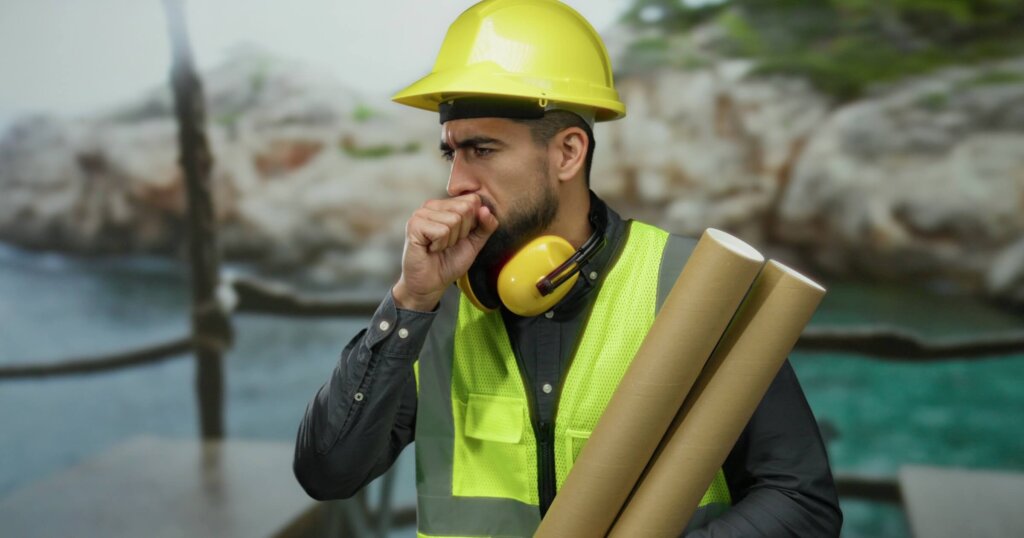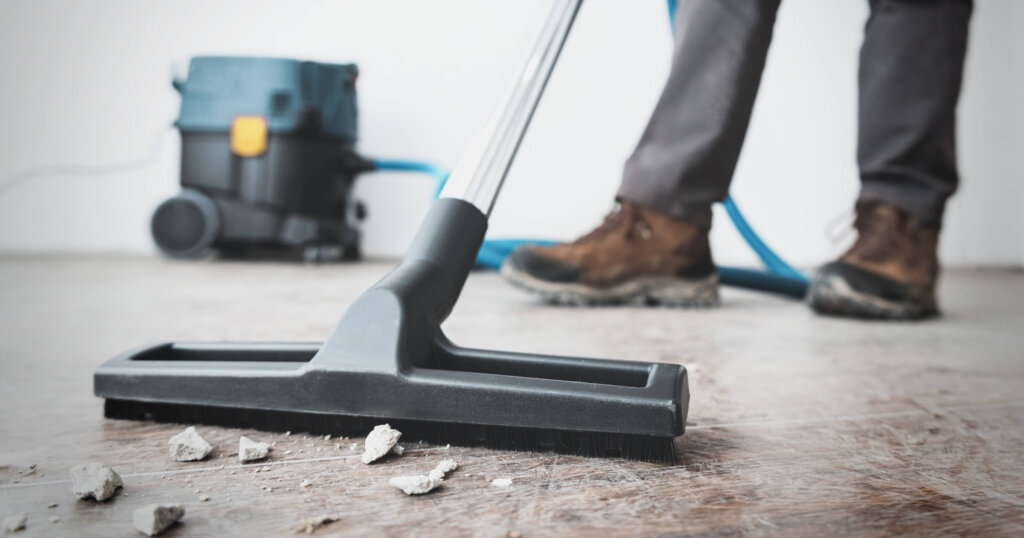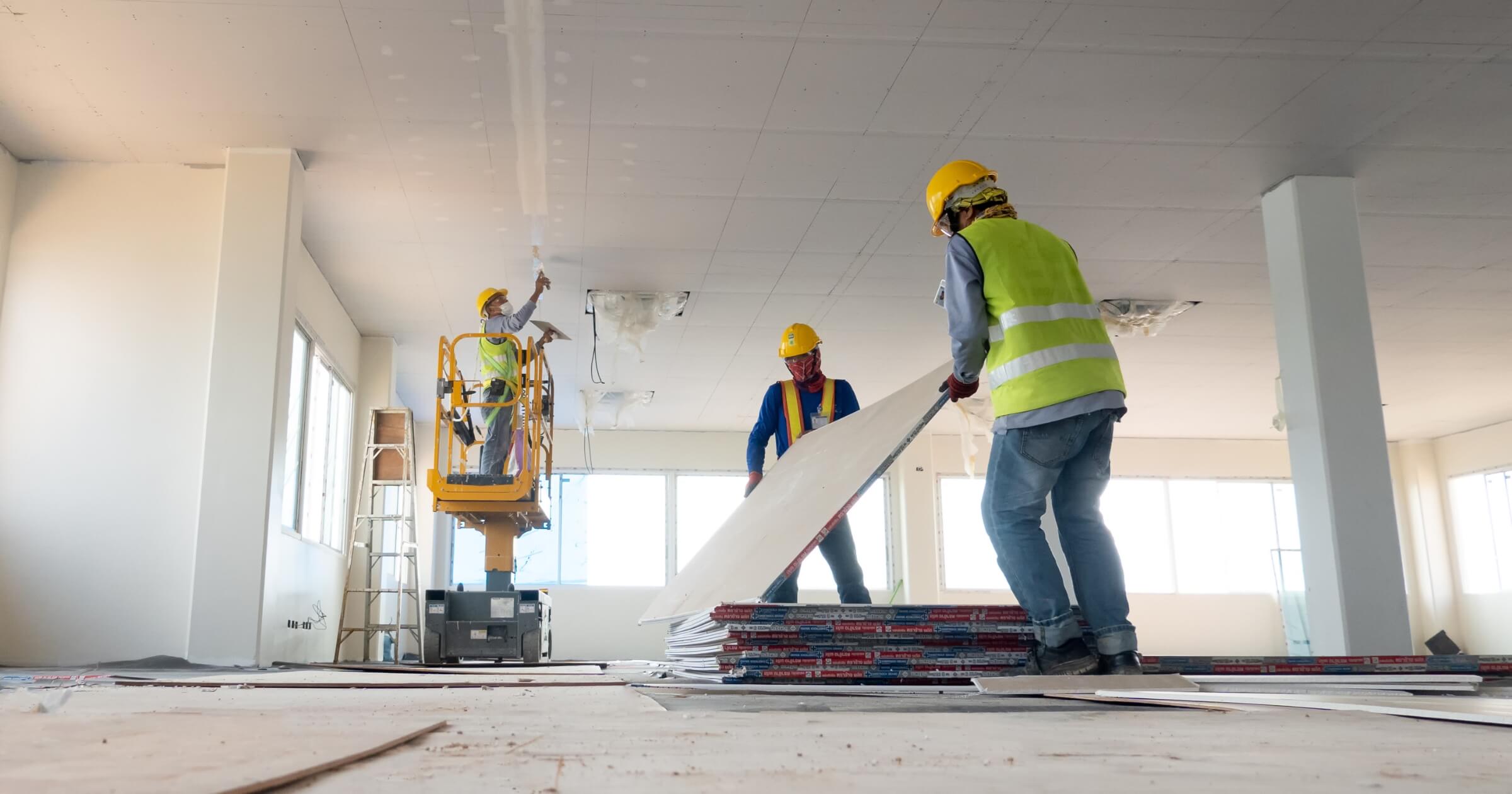Breathing drywall dust can pose serious real health risks without proper PPE. Whether you’re a DIY enthusiast tackling a weekend repair or a professional finishing multiple homes per week, understanding how much exposure to drywall dust is dangerous matters. Drywall dust remains airborne long after sanding stops, invading your lungs, skin, and eyes. Recognizing the components, safe exposure limits, and proper cleanup procedures can help keep projects on track while protecting your health and well-being.
Quick look
- Short term exposure to drywall dust can irritate the eyes, lungs, and skin, especially in poorly ventilated spaces.
- Long-term exposure, particularly to silica in taping compounds, may increase the risk of chronic respiratory issues.
- OSHA does not classify gypsum dust as hazardous, but overexposure can still trigger occupational asthma and inflammation.
- Wet sanding, HEPA vacuums, and dust-control joint compounds significantly reduce the number of airborne particles during finishing work.
- Best practices include engineering controls, PPE, and administrative measures like zoning, task rotation, and worker training.
What is drywall dust?
Drywall dust is a fine particulate mix that’s kicked up when sanding gypsum board or joint compound. The main component—gypsum (calcium sulfate)—forms the bulk of the dust cloud. Paper fibers from wrapped drywall sheets can float and lodge in the nasal passages. You’ll also find fillers like talc, mica, calcite, perlite, and occasionally small amounts of respirable crystalline silica. While most joint compounds are low in silica, older formulations or specialty products may contain more.
Particles under 10 microns can penetrate deep into your lungs. Both the NIOSH and CDC warn about the long-term inhalation risks associated with dust accumulation in enclosed spaces. That means using proper ventilation and ensuring protective gear is worn. Checking Safety Data Sheets can help you identify whether the compound you’re using contains higher silica levels, allowing you to plan controls accordingly.
How much drywall dust is too much?
According to OSHA, the maximum amount of total airborne dust a worker should be exposed to is 15 milligrams per cubic metre of air (mg/m³). For respirable dust, the tiny particles that are small enough to enter the lungs, the limit is 5 mg/m³, averaged over an 8-hour workday. When it comes to respirable crystalline silica, which is a particularly harmful substance sometimes found in joint compounds, the limit is even stricter: just 0.05 mg/m³. This aligns with the NIOSH recommended exposure level, or REL.
To understand what that means on the job, even a short drywall sanding session—say, 15 to 30 minutes in a small, unventilated room—can produce enough fine dust to exceed these limits. Once levels exceed the safe threshold, workers face a higher risk of developing lung issues, such as chronic bronchitis, asthma, or long-term conditions like silicosis. The danger escalates even more rapidly if the drywall compound contains a higher percentage of crystalline silica. This is why proper dust control, protective gear, and ventilation are crucial, especially during high-dust tasks such as sanding or demolition.
Using an air sampling pump is the only way to confirm actual exposure. Short-term (15-minute) sampling can reveal peaks that exceed safe levels, even if the overall TWA appears to be within limits. This data helps assess whether your controls, such as vacuums or wet sanding, are doing their job.
Short-term health effects of drywall dust

Photo courtesy of https://www.shutterstock.com/
Throat irritation
Drywall dust particles can scratch the sensitive mucous membrane lining your throat. This often leads to a severe scratchy sensation, especially after extended sanding without proper respiratory protection. The irritation can persist into the afternoon or evening, making swallowing or talking uncomfortable. Hydration provides temporary relief, but clearing dust from the air offers the only permanent solution.
Coughing
Dust irritates the throat and respiratory tract, leading to persistent coughing. During overhead sanding or joint finishing, many tradespeople report bouts of coughing immediately after stepping away from the task. Without a fitted respirator, even short sanding sessions can trigger repeated coughing fits. This slows productivity and may lead to missed work or discomfort for the rest of the day.
Itchy or burning eyes
Once airborne, dust particles can float into the eyes, especially with indirect currents from open doors or windows. Rubbing the eyes worsens the problem by embedding tiny particles into the lids or the surface. To prevent this, sealed goggles are essential, even though they may fog in humid conditions. Eye drops can help, but won’t solve the source of the problem.
Skin irritation
Drywall dust, which contains talc, mica, and calcite, can scratch your skin, causing dryness or mild dermatitis. Areas like the forearms, neck, or lower legs often bear the brunt after hours of sanding. Washing after work and using a gentle lotion helps, but not as effectively as wearing gloves and long sleeves. Remember, repeated exposure can cause the skin to become more sensitive over time.
Long-term health risks

Photo courtesy of https://www.shutterstock.com/
Asthma-like symptoms
Repeated exposure to drywall dust can cause asthma-like symptoms, including wheezing, chest tightness, and labored breathing. Some workers develop these conditions after years of working, even with relatively low daily exposure. Dust sensitization can occur gradually, leading to symptoms even when dust levels are moderate. Medical tests often confirm occupational asthma caused by dust, necessitating proper protective measures or job changes.
Chronic bronchitis
Frequent coughing and sputum production are signs of chronic bronchitis, which can result from long-term exposure to dust. The inhaled particulates inflame bronchial tubes, increasing mucus production. That reaction becomes a recurring cycle: cough, cleaning sputum, rest, repeat. Over time, the lungs may develop scar tissue, restricting airflow and reducing lung capacity.
Silicosis
Some joint compounds contain higher amounts of crystalline silica. Long after you’ve stopped drywall work, silica particles embedded in deep lung tissue can cause silicosis—a chronic and irreversible disease marked by lung scarring. Symptoms include a persistent cough, shortness of breath, and a tendency to frequent infections. Early detection is rare, as the initial stages often show few symptoms. This condition is incurable and becomes debilitating over time.
Lung cancer
The IARC classifies silica dust as a Group 1 carcinogen. Long-term exposure—even in smaller doses—can still elevate lung cancer risk, particularly in workers also exposed to other industrial hazards. While general drywall dust isn’t high in silica, cumulative exposure over decades still matters. Non-smoking finishers exposed to dust still show small but measurable increases in respiratory cancer rates.
Reduced lung capacity
Repeated exposure to fine particulates can gradually reduce total lung capacity. Workers may notice that climbing stairs or carrying materials causes them to experience unusual breathlessness. This isn’t simply aging—it often stems from dust-related inflammation or tissue damage. Regular lung function tests (spirometry) help catch declines earlier.
Best practices & controls to minimize exposure

Photo courtesy of https://www.shutterstock.com/
Elimination or substitution
Switching to dust-control joint compounds is a simple yet effective way to cut down airborne particles. These compounds are designed to clump rather than float when sanded. Trials have shown that dust-control compounds reduce airborne dust by over 60%. Wet sanding offers an even greater reduction, but it takes longer to dry, which in turn can impact schedules. Always choose products rated for low-dust performance when available. Some contractors also opt to pre-texture surfaces or use prefabricated drywall panels to minimize finishing. These small changes at the material selection stage can significantly reduce the need for airborne dust-producing work later on.
Engineering controls
Installing a HEPA-rated vacuum sander can remove captured dust at the source. These units collect most particles before they escape into the air. Negative-air machines with ducted exhaust can create under-pressure in enclosed rooms, drawing dust away from workers. Setting up air scrubbers and effective intake/exhaust points lifts dust before it spreads. Engineering controls reduce exposure continuously without relying on worker behavior. On large sites, it is a good idea to install centralized dust collection units that service multiple sanding crews through a network of ductwork. Equipment placement and airflow testing are crucial to ensure controls are functioning as intended.
Administrative controls
Designate sanding zones away from occupied or finished areas to contain dust spread. Limit worker access by setting up plastic barriers and posting visual warning signs. Schedule sanding before other critical trades enter to avoid cross-contamination. Rotate workers between tasks to limit dust exposure duration. Provide training on dust hazards, symptom awareness, and safe sanding techniques during toolbox talks or onboarding. Encourage crews to report any malfunctioning tools or dust clouds that might exceed expected levels. Simple administrative steps, such as regular site walkthroughs and signage updates, can reinforce compliance across trades.
Personal protective equipment (PPE)
A properly fitted N95 mask protects against larger particles, while a P100 respirator is better for fine silica or heavy-duty sanding. Dust can hide in goggles and cause harm to the eyes quickly; sealed goggles or full-face respirators offer better protection than open safety glasses. Long-sleeve shirts and gloves help prevent skin soreness and itching. Respiratory fit testing ensures that masks seal correctly, and regularly replacing filters or cartridges maintains protection levels. PPE serves as the last line of defense, and only works when used correctly. Supervisors should periodically check compliance and store backup gear on-site in case masks become damaged. PPE usage logs can also help identify patterns in exposure and flag repeat offenders who may require retraining.
When to seek medical advice or air testing
If you or team members experience persistent coughing, chest tightness, shortness of breath, or unusual drowsiness after drywall work, seek medical advice. These symptoms may signal early respiratory issues. Request an occupational lung evaluation that includes spirometry and a detailed exposure history.
Consider getting the air tested when:
- Symptoms appear across more than one worker
- Sanding occurs in enclosed or poorly ventilated areas
- You’re using older drywall products or compounds with unknown silica content
- Daily exposure exceeds a few hours
Certified industrial hygienists can measure levels of total dust, respirable dust, and silica using calibrated pumps and filters. This data forms the basis for improving controls and setting future protections.
Key takeaways
- How much exposure to drywall dust is dangerous? OSHA limits are 5 mg/m³ for respirable dust and 0.05 mg/m³ for silica; exposures above these levels pose health risks.
- Short-term exposure to drywall dust can cause throat irritation, coughing, eye discomfort, and skin irritation after a single session.
- Is drywall dust toxic? Some of it is. Dust containing respirable silica can lead to long-term lung diseases and increased cancer risk.
- The best way to clean up drywall dust is to use HEPA-filtered vacuums, wet wipes, and avoid dry sweeping or using shop vacs without filters.
- Protect yourself and your crew by combining dust-control compounds, engineering measures, administrative planning, and properly fitted PPE.
- Track signs and seek medical or air testing whenever symptoms persist or exposure appears to be above safe levels.
Find more job site safety tips by checking out these articles:
- How OSHA’s revised PPE standard impacts construction safety in 2025
- Smart PPE in construction: Benefits, costs, and challenges
- How to make respiratory safety a priority in the construction industry
Looking to keep your crews safe from air hazards and other common risks? Subscribe to our Under the Hard Hat newsletter or jobsite-tested advice based on field experience.


